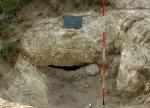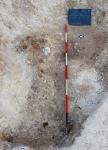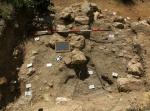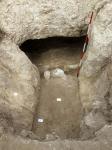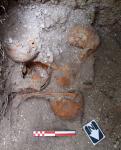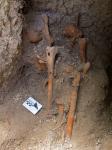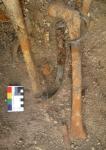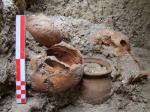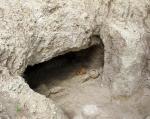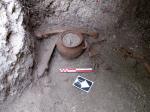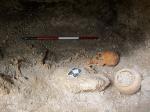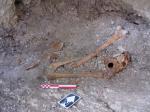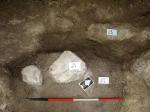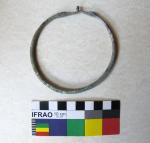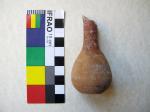Summary (English)
Trench 1, locality of Giardino a Caldo
Continuation of the research in the eastern part of the trench, below the levels of abandonment and modern re-occupation (phases 3 and 4), provided further clarification of the sequence relating to the second occupation phase, identifiable with the building of a partially-paved stone and mortar structure. This was attested by a patch of floor found in 2014 in the south-eastern corner of the trench, bedded above the east perimeter wall of the phase 1 structure. The layers above this wall contained pottery and metal finds, including a bronze fibula with foliate bow. The stratigraphic evidence suggests the presence of a possible boundary between two different areas or rooms. At present it is not possible to establish whether this zone was outside or inside the structure, of which neither the extension or layout is known. In 2015, it was decided to halt the excavation above the phase 1 levels. The complex dates to between the 4th and 6th centuries A.D.Locality of Lame Soriano
Cleaning along the south slope of the Colle di Caccialepre documented the excavations carried out in 1990 in order to tap the local springs. GPS point 1: three inhumation burials were identified in this area that were part of an “a grotticella” tomb (grotticella 1) removed by mechanical digger in the last century. Pottery fragments and bones from the same context were recovered in the area. Along the slope, about five metres west of GPS point 1, a second “a grotticella” tomb (grotticella 2) was discovered, this time intact. The tomb had a trapezoidal plan, on an east-west alignment with a south-facing entrance, and dromos aligned north-south sloping downwards following the line of the hill. Skeletal remains, pottery fragments and two strigils were found in the partially excavated corridor. The tomb entrance was sealed by a dry-stone diaphragm. The cavity contained a burial in primary deposition (deposition 2) and two reductions, situated in the south-western corner of the tomb (deposition 1) and in correspondence with the north-western corner/north wall (deposition 3).Deposition 1: four crania and other skeletal remains were placed around and above a jar. The remains included several femurs, on one of which a bronze wire armlet had been placed. Beside the femur was a bronze strigil with iron handle.
Deposition 2: this was the burial in primary deposition of an adult male, placed on an east-west alignment in the centre of the tomb. The tomb group comprised a jar, three balsamarii and an iron ring.
Deposition 3: the remains of several adults and a foetus; an iron strigil partially covered one femur.
The removal of the archaeological deposit revealed channels cut into the limestone bedrock running east-west, in front of the northern part of the tomb.
- Francesca Romana Del Fattore
- Alessandro Felici
Director
- Andrea Schiappelli – Matrix 96 Società Cooperativa
- Antonio Curci - Dipartimento di Storia Culture Civiltà – Università degli Studi di Bologna “Alma Mater Studiorum”
- Francesca Romana Del Fattore – Matrix 96 Società Cooperativa
Team
- Anna Rizzo - Dipartimento di Storia Culture Civiltà – Università degli Studi di Bologna “Alma Mater Studiorum”
- Melania Gigante – Sezione di Bioarcheologia Museo Preistorico ed Etnografico "Luigi Pigorini"
- Lionello Morandi – University of Reading – Department of Archaeology, School of Human and Environmental Sciences
- Veronica Villa – Accademia di Belle Arti di Bologna
- Barbara Ottani - Università di Bologna
- Gabriella Giovannone – Università degli Studi di Napoli “L’Orientale”
- Chiara Tebaldi – Dipartimento di Storia Culture Civiltà – Università degli Studi di Bologna “Alma Mater Studiorum”
- Gianfranco de Rossi
- Enrica Gori - Dipartimento di Storia Culture Civiltà – Università degli Studi di Bologna “Alma Mater Studiorum”
- Alessandro Felici – Matrix 96 Società Cooperativa
Research Body
- Centro di Ricerche di Bioarcheologia – ArcheoLaBio, Dipartimento di Storia Culture Civiltà, Università degli Studi di Bologna “Alma Mater Studiorum”
- Sezione di Bioarcheologia Museo Preistorico ed Etnografico "Luigi Pigorini"
Funding Body
- Comune di Scanno
- Matrix 96 Società Cooperativa
- Rotary Club Roma Ovest






![Download [PDF]](/excavation/skins/fasti/images/results/download_sml.png)
